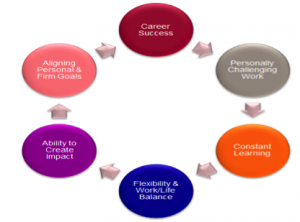Posted In: Talent Strategy
The Only Constant is Change: Are Your Staffing Models Adapting?
Famous for his insistence on ever-present change in the universe, pre-Socratic Greek philosopher Heraclitus is most well-known for his quotation “Change is the only constant in life.” I’ve found that law firm leaders are increasingly willing to embrace change on an institutional level in terms of compensation systems, governance structures and alternative fee arrangements; however, the restructuring of non-attorney roles is often overlooked. The oversight is significant when you consider the drain on profitability that outdated staffing models can create.
I was recently asked to provide comment for an article in the latest issue of Legal Management, the Magazine of the Association of Legal Administrators. The article is an insightful overview of trends affecting traditional law firm staffing and provides sage advice for seamlessly adopting modified staff roles.
When it comes to evolving non-attorney staffing models, what is holding your firm back from implementing change? Here are four common roadblocks:
- I’m overwhelmed and don’t know where to begin
- I’m afraid to change
- It’s easier not to change
- The staff at my firm doesn’t want to change
Let’s examine these familiar obstacles one at a time.
1. I’m overwhelmed and don’t know where to begin
Feeling overwhelmed often comes from a lack of knowledge. The Legal Management article is a great starting point to understand changes being implemented by progressive law firms and the impact to their bottom line. The article addresses evolution in the roles of assistants, law librarians, paralegals, marketing professionals and IT professionals, but there is no need to jump in and modify every role at all at once. Starting small is an easy way to manage the information overload and keep from feeling overwhelmed.
2. I’m afraid to change
Fear of change is common, but in today’s competitive legal landscape your firm will get passed up if you don’t embrace it. I know, I can hear my mother saying “If everyone jumped off a bridge…”, but by failing to jump you put your firm at a significant competitive disadvantage. If you put the proper parachutes in place with research, accountability, buy-in, clear communication and proper planning, you can alleviate some of the fear and make the jump feel less risky.
3. It’s easier not to change
Perhaps. At least it may be more comfortable in the short run. But in the long run, the pain that comes from failing to change will far outweigh the temporary discomfort of reexamining the non-attorney roles at your firm. Obsolescence resulting from outdated staffing models may ultimately lead to layoffs, redundancy, and diminished employee morale. Facing those issues can be much more painful than a methodical, thoughtful approach to reinventing staffing models.
4. The staff at my firm doesn’t want to change
Presuming that staff members are content with the status quo isn’t always a safe assumption. Consider the following six elements essential to developing an engaged workforce:
By failing to evaluate staffing models, you may inadvertently undermine the engagement of your staff. Reassigning roles can bring a surprising influx of new energy. For example, involving marketing teams in strategy and empowering law librarians to research industry trends not only benefits the firm, but expands the skill sets of your team members. Rather than assuming that staff members are resistant to new talent models, savvy firms use focus groups, surveys and individual interviews to understand employee engagement and identify new skills to benefit both team members and the firm.
If you find yourself adverse to change, you’re certainly not alone. In the 2500 years since Heraclitus declared that change was the only constant in life, some have embraced adjustments whereas many others have failed to adapt. Some changes are more difficult than others, but modifying non-attorney staffing roles shouldn’t be a daunting undertaking- What’s holding you back?

No Comments